At British Columbia’s Queen Charlotte Lodge, guests catch king salmon and live like kings. The sprawling waterfront resort dazzles with its top-notch fishing and forested island accessible only by helicopter.
by Doug Thompson
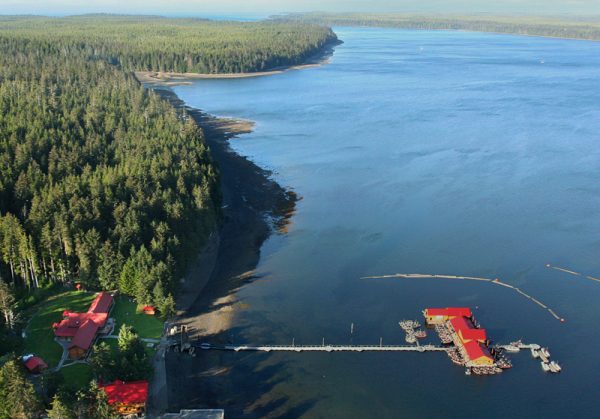 Helicopter rides rank high with me. My last ride in a 12-passenger Bell Jet Ranger was a big deal. It ferried me and some old friends to the Queen Charlotte Lodge for five days of king salmon fishing on the north side of the Queen Charlotte Islands, just 50 miles from the southeastern tip of Alaska.
Helicopter rides rank high with me. My last ride in a 12-passenger Bell Jet Ranger was a big deal. It ferried me and some old friends to the Queen Charlotte Lodge for five days of king salmon fishing on the north side of the Queen Charlotte Islands, just 50 miles from the southeastern tip of Alaska.
As the helicopter set down on the landing pad in Naden Harbor, the entire lodge staff greeted our group, waiting with open arms as we walked under the whirling blades onto the dock. The lodge opened in 1990 on the site of a Haida whaling village. Remnants remain, including a stone pillar on the shoreline that served as a marker for Haida whaling boats. We sat down for a lunch of crab meat soup, buffalo chili, coleslaw, sausages, and salad. We ate heartily but quickly because eight hours of daylight remained. And because Corey Helm, our de facto trip leader, had prepped me for what lay head.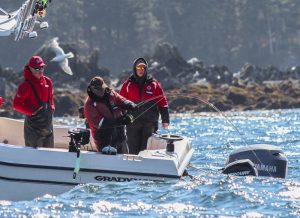 “Finish your lunch,” said general manager Paul Clough. “You guys are going fishing.
“Finish your lunch,” said general manager Paul Clough. “You guys are going fishing.
Trolling and catching
At the docks we jumped into the rubber boots, coveralls, and warm waterproof jackets. After a 30-minute run in a 22-foot aluminum fishing boat with our guide Jason Drury, we rigged up four lines and, amid spectacular scenery, we trolled. And trolled. And trolled. The trick is to present your trolled bait as a wounded fish. The salmon think it’s an easy meal. My fishing partner Scott Lewer and I chatted about old times, loosened our jackets under clear skies and 65-degree temperatures. Our rod tips did nothing. More than 30 boats from six lodges, including the Queen Charlotte, crisscrossed an area known as Bird Rock I where the salmon come through in schools and feed on baitfish at depths from 30 feet to 60 feet.
We were so close to other boats, we could watch them hook, fight, and land their fish. And hear  their joyous screams. Bart Overturf, a member of our group, scored first when he landed a 48-pound King salmon, and screamed “Tyee.” Tyee is the colloquial name for a King salmon larger than 30 pounds.
their joyous screams. Bart Overturf, a member of our group, scored first when he landed a 48-pound King salmon, and screamed “Tyee.” Tyee is the colloquial name for a King salmon larger than 30 pounds.
We did have some fishing alternatives, including running a few miles out to fish for Pacific halibut. Our guide quickly agreed to this plan, and we ran out five miles to a spot he identified on the boat’s GPS unit. We rigged up two deep-water fishing rods, and dropped them down 200 feet. Within seconds, my rod tip tapped, jiggled, and then bowed down. I set the hook and cranked up a 12-pound halibut, and flopped the flat fish on deck. Into the fish box the halibut went, and we caught two more within an hour.
“What’s next?” I wondered aloud as we motored back toward the coast.
Fish-fry time
“An old-fashioned Friday fish fry,” Jason said, and pointed toward the MV Driftwood, a 110-foot refurbished tug boat that serves as a floating home base for anglers, with accommodations for 12. Aboard the Driftwood, chef Jin Chong treated us to a halibut fish fry. Standing aboard the tugboat with the Canadian forest in the background, I sipped Chardonnay from crystal stemware—still in my fishing coveralls, rubber boots and rain jacket—eating Jin Chong’s freshly fried hot halibut with my fingers.
Disembarking in Naden Harbor, we finally got a good look at the lodge, which is centered around a huge stone fireplace, and our guestrooms. These feature log-cabin décor, with cedar walls and rustic accents, and rooms that accommodate three to four guests in twin beds. The rooms are primarily for sleeping, and sleeping is minimal.
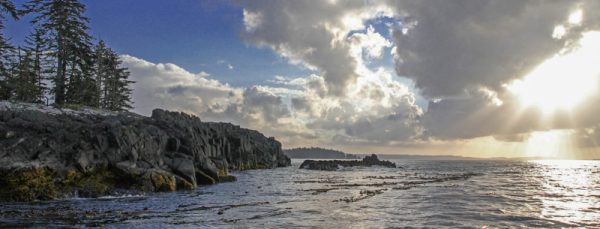 Guests tend to rise at 5 a.m. to go fishing at first light, though they seldom get to bed before midnight. After dinner, there’s poker, billiards, darts, star-gazing, or soaking in the hot tub in the wooden gazebo on the front lawn.
Guests tend to rise at 5 a.m. to go fishing at first light, though they seldom get to bed before midnight. After dinner, there’s poker, billiards, darts, star-gazing, or soaking in the hot tub in the wooden gazebo on the front lawn.
The third dinner was a highlight, featuring broccoli soup and seared albacore tuna as an appetizer, followed by prime rib with dauphinoise potatoes and vegetables, Coho salmon Wellington filled with spinach and mushrooms in a puff pastry, and braised beef short ribs simmered low and slow in red wine with bacon and onions. The wine that evening was the Carmen Reserve Carmenere/Cabernet from Chile’s Maipo Valley. The meal concluded with white and dark chocolate pâtés with fresh blueberry sauce. The last full day of fishing was only six hours away.
Big fight with a king
This was the day that a Chinook salmon made the final mistake of its life: it mistook my herring baitfish for a real meal. My eight-foot rod tip-tapped down once outside of Bird Rock I (there is a Bird Rock II, just so you know), then twice, and I quickly stripped out a few feet of my line so the bait free-fell.
Then came the take, as the salmon swallowed the bait and the rod bowed down. I reeled as fast as I could. “This is far too easy,” I thought, as the fish rolled to the surface 20 yards out. “Now he’s going to run,” yelled Jason. “Keep steady pressure, and let him take out line if he runs.”
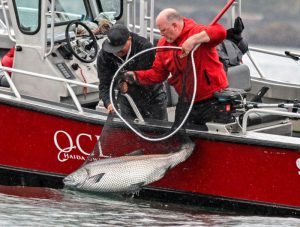 But the fish let itself get dragged over the water to the boat. A possum play, perhaps? I held the rod straight with my left hand and palmed the one-speed reel with my right. Waiting for the fight, I stumbled just a little bit in a big swell. At that instant the fish took off, stripping off line and spinning the reel’s two cranking handles like a garbage grinder. My knuckles and palms took a repeated busting before I could get them out of the way, the reel still screaming as line peeled out.
But the fish let itself get dragged over the water to the boat. A possum play, perhaps? I held the rod straight with my left hand and palmed the one-speed reel with my right. Waiting for the fight, I stumbled just a little bit in a big swell. At that instant the fish took off, stripping off line and spinning the reel’s two cranking handles like a garbage grinder. My knuckles and palms took a repeated busting before I could get them out of the way, the reel still screaming as line peeled out.
I tried to keep pressure, and the fish moved in short fits, pulling some, then going completely slack. “If he gives you line, take it fast and keep the pressure on,” Jason said. I’d heard that advice once before when I caught a salmon off the Southern California coast, but that was a 12-pounder, less than half the size of this freight train!
I kept the pressure on and reeled. The fish surfaced again and jumped completely out of the water in an attempt to spit the barbless hooks. As I kept the line tight, the fish ran me around the fishing boat, and my partner quickly reeled in his line to avoid any tangles. We all wanted this one in the boat.
Caught in a true fight with a true Chinook salmon, I wanted it to last forever and to end at once. On the northern horizon I could see the Alexander Archipelago in Alaska. A bald eagle flew overhead, and I thought I saw a black bear on the shore. Earlier that day, orcas had breached within sight. I tried to burn the memories into my brain, and hoped the fight would not end with my knuckles busted and my heart broken. I wanted this fish in the boat, on the dinner table, and printed on my resume.
Landing a whopper
The fish tired and this time I half-guided, half-dragged it to the boat. Jason dipped the wide net into the water, scooped up the salmon, removed the hooks, and laid the flapping fish on the deck.
I took a hard look at the salmon, which weighed 30 pounds. Its mouth was larger, darker, and filled with more teeth than I ever imagined. Its sides were solid muscle and cold to the touch from the 58-degree water. There was one more job to do and I lifted a wooden bat. Afterward I posed and preened with the dead fish. Later in the lodge I marveled at the fish’s size, as I viewed photos of my fish.
After dinner, I was presented with a Tyee pin, the reward for catching a salmon of 30 pounds. I snapped the pin on my fishing cap, not realizing its significance until our departure the next day. It meant success, but it also meant the end. The end of our trip, the end of one particular salmon’s life, the end of my fishing innocence when it came to catching a big king.
As I trudged to the helicopter pad, a grizzled veteran, a fresh-faced guest climbed out, shook hands with the staff, and caught sight of my Tyee pin. “How was it?” he asked. “Great,” I said, hefting a 60-pound box of flash-frozen salmon. Then I said, “Enjoy it while it lasts.”
 Doug Thompson is a boating, outdoors adventure and travel writer living in Ventura, California. He posts many of his stories on his blog.
Doug Thompson is a boating, outdoors adventure and travel writer living in Ventura, California. He posts many of his stories on his blog.
—photography courtesy of Queen Charlotte Lodge.
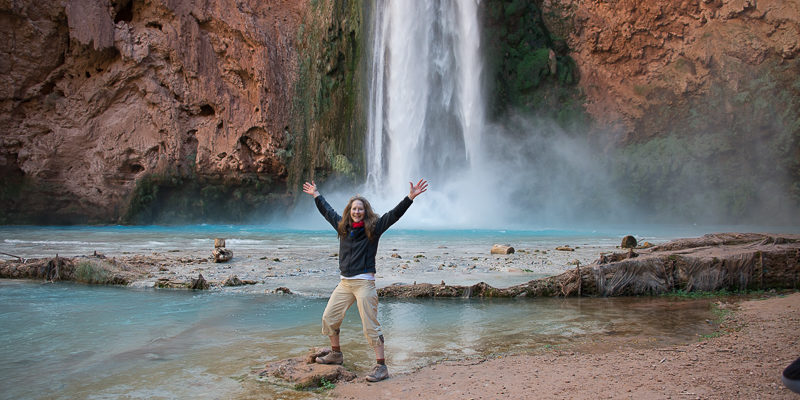
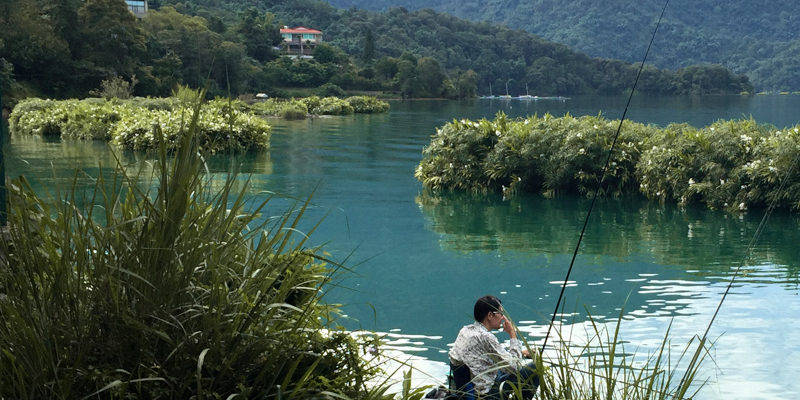



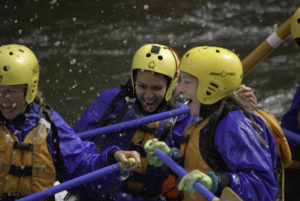
Leave a Reply